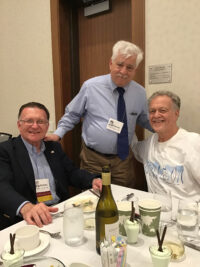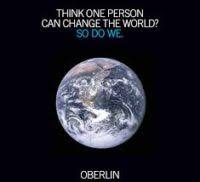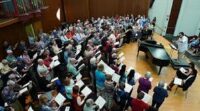
A Fiftieth Reunion–Take 2
I rarely find it hard to write these blog posts.
I kept putting this one off, however.
Not because it was intellectually hard to put together. Instead, it was hard to put the emotional pieces together in a way that would make sense to someone who did not go to Oberlin or any similar institution in the late 1960s.
I finally figured out how to do it by putting the discussion of the picture of Mike Lubas, Michael Jarvis, and me that begins the post at its end and build up to it.
At first glance, the picture might strike you as typical of a fiftieth reunion. Three old(er) guys at a formal banquet held in a meeting room with evidence of some drinking taking place. The one who had had a speaking role wearing a tie.
 Oberlin reunions, however, are not typical reunions. After all, the college markets itself with this image that recruits students who want to change the world. That’s why I went there.
Oberlin reunions, however, are not typical reunions. After all, the college markets itself with this image that recruits students who want to change the world. That’s why I went there.
So, reunions don’t have golf tournament. They have lots of intense discussions instead. For most of us, the highlights of the weekend are the men’s and women’s breakfasts which we have been holding since our 25th reunion.
In planning the weekend, we wanted to give people plenty of time to explore how we are aging and how we continue the activism of our youth, while letting our classmates see that Oberlin is still a vibrant place. Oberlin being Oberlin, that also meant including lots of music.
:Lead reunion organizer Walt Galloway started things off by reminding us that when we graduated in 1969, the class of 1919 was celebrating its fiftieth reunion. That set us off on a series of reflections, at least some of which had takeaways for non-Obies as symbolized in the picture of Mike, Michael, and me.
- Let young people lead. A friend and I were asked to organize a booklet of advice our classmates offered to the class of 2019. We agreed to do it only if the class of 2019 would do the same for us which we collected in a little booklet. Their advice to us was pithier than what we said to them. The booklet and our discussions convinced me that it is time for our generation to get out of the way and let this remarkable gang of young people take the lead when it comes to social change.
- Aging can be fun—and rewarding. We are all showing signs of aging physically, even my roommate from freshman and senior year who still plays soccer every week. I was amazed, however, at how few of us have aged (much) mentally. In other words, we still have a lot to contribute. Most of us also have more time on our hands than we used to, and few of us will be happy simply playing golf or going on cruises. I was delighted to see how many of us are finding useful outlets where we can still make a difference.
- Keep Learning. Oberlin is an intense place in many ways, starting with the classroom. So, one of the high points of the evening at that banquet were not just one, but two, talks by faculty members. Brian Alegant told us about how he redesigned his music theory courses so that the students chart their own way through difficult topics like atonal music, empower themselves, and become better musicians which earned him national professor of the year honors. My friend Cindy Frantz talked about the psychological forces that leave people open to and/or reluctant to change by contrasting today’s generation of Oberlin activists with ours. The discussion with the two of them could have gone on for hours.
- Be twenty-first century activists. Other than the banquet and the memorial service, the biggest draw of the weekend was a discussion of progressive activism that had about 150 participants. Non-Oberlin readers should know that our generation of Obies is best known for a demonstration in which we blocked a military recruiter’s car on the streets of town that I helped organize. More importantly, almost all of us are worried about the state of the country today which is what the sessions was about. We worked in table groups of six to ten classmates, only some of whom are activists today. Almost all of the tables reached what for me were surprising and delightful conclusions. Rather than engaging in the 2019 equivalent of the recruiter demonstration and simply “naming and shaming” the Trump administration, almost all of my classmates talked about how they could both hold true to their progressive beliefs and help bridge the divides that are beginning to tear our country apart. I kept hearing terms like listen, respect, dignity, getting to know “the other,” empathy.
 And that takes me to the photo which, in many ways, says it all. Most of us have spent the last fifty years growing in ways that both make us more interesting now than we were then and open the door to intriguing opportunities in whatever time we have left.
And that takes me to the photo which, in many ways, says it all. Most of us have spent the last fifty years growing in ways that both make us more interesting now than we were then and open the door to intriguing opportunities in whatever time we have left.
Mike, Michael, and I barely knew each other fifty years ago. I was a hard core activist and budding political scientist. Michael was a psychology major and nationally ranked swimmer—he went on to set world records at the 2002 Gay Games. Mike was a religion major who insisted on seeing the recruiter we protested against on another occasion so that he could finish the paperwork for becoming a military chaplain. He still is one of the most conservative of our classmates.
They became friends when they were in neighboring seminaries after we graduated and explored their similarities and differences while Michael was coming out and Mike was settling in to the life of a Lutheran pastor. I really got to know them both more recently. Michael and I connected through the first men’s breakfast twenty-five years ago. We co-facilitated the one this year. Mike is a newer friend, and our bond is based on the fact we come from different places politically and enjoy the time we spend with each other, in large part because we spend so much time in our own political bubbles. We decided to sit together precisely because we revel in our differences and bask in the ways each of us—and most of our classmates—have grown since those days when our hair color was not yet challenged.
The views and opinions expressed in this article are those of the author and do not necessarily reflect the official policy or position of the Alliance for Peacebuilding or its members.
